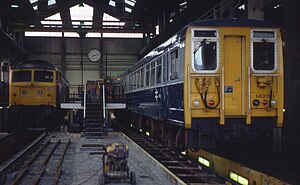| British Rail Class 140 Pacer | |
|---|---|
 Class 140 (right) at Landore TMD, Swansea, in 1982 | |
| In service | 1981 – c. 1986 |
| Manufacturer | |
| Order no. | 30962[2] |
| Built at | Derby Litchurch Lane Works[2] |
| Family name | Pacer |
| Constructed | 1979–1981[3] |
| Number built | 1 |
| Number preserved | 1 |
| Formation | 2 vehicles: DMSL-DMS |
| Diagram |
|
| Fleet numbers |
|
| Capacity | 102 seats[2] |
| Operators | British Rail |
| Depots | Neville Hill (Leeds)[2] |
| Specifications | |
| Car body construction | Steel[1] |
| Car length | 15.878 m (52 ft 1.1 in)[1] |
| Width |
|
| Height | 3.906 m (12 ft 9.8 in)[1] |
| Floor height | 1.215 m (3 ft 11.8 in)[1] |
| Doors | 3 per side |
| Wheel diameter | 840 mm (2 ft 9 in)[1] |
| Wheelbase | 9.000 m (29 ft 6.3 in)[1] |
| Maximum speed | 75 mph (121 km/h) |
| Weight |
|
| Prime mover(s) | 2 × Leyland TL11 (one per vehicle)[1] |
| Engine type | Inline-6 4-stroke turbo-diesel[4] |
| Displacement | 11.1 L (680 cu in) per engine[4] |
| Power output | 153 kW (205 hp) per engine[2] |
| Transmission | SCG R.500 (4-sp. epicyclic)[5] |
| Minimum turning radius | 70 m (230 ft)[1] |
| Braking system(s) | Electro-pneumatic (tread) ('Westcode') |
| Safety system(s) | AWS |
| Coupling system | Tightlock[1] |
| Multiple working | Not fitted[1] |
| Track gauge | 1,435 mm (4 ft 8+1⁄2 in) standard gauge |
The British Rail Class 140 was the prototype of the Pacer diesel multiple unit.
It was constructed between 1979 and 1981 in response to a desire within British Rail to develop a capable railbus for its smaller branch line services. Much of the bodywork was constructed using Leyland National bus components, with the exception of the cabs. Based on the single car railbus prototypes, the Class 140 was built to BR's then stringent regulations regarding crashworthiness and resistance to end loading; as such, much of its intention lightweight 'bus on a wagon' look was lost, becoming a more substantial vehicle. Throughout the 1980s, the sole member of the class functioned as a trials and demonstration unit, acting as a herald to the closely related Class 141. Since its withdrawal, the unit has been preserved at the Keith and Dufftown Railway.
- ^ a b c d e f g h i j k l m Vehicle Diagram Book No. 220 for Diesel Multiple Unit Trains (Railcars) (PDF). Derby: British Railways Board. 1982. DP222 & DP223. Archived from the original (PDF) on 21 January 2015. Retrieved 19 February 2016 – via Barrowmore MRG.
- ^ a b c d e f g Fox, Peter (1987). British Railways Pocket Book No. 2: Multiple Units (Summer–Autumn 1987 ed.). Sheffield: Platform 5 Publishing. p. 40. ISBN 0906579740. OCLC 613347580.
- ^ Cite error: The named reference
Smith3was invoked but never defined (see the help page). - ^ a b Leyland Titan Technical Data (PDF). Southall: British Leyland UK. June 1978. Lit. No. 1683. Archived (PDF) from the original on 31 January 2022. Retrieved 21 December 2022.
- ^ "Class 140". The Railway Centre. Archived from the original on 9 March 2005.
